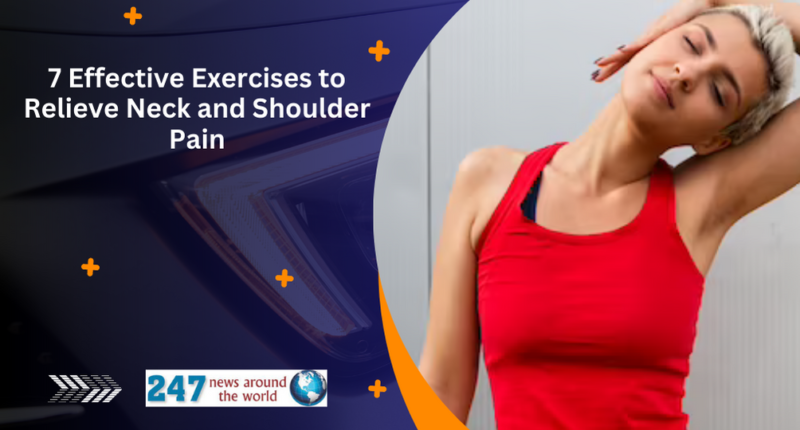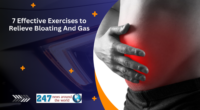A look at “7 Effective Exercises to Relieve Neck and Shoulder Pain” Neck and shoulder pain can be debilitating, affecting your daily activities and overall quality of life. Thankfully, there are simple yet powerful exercises that can help alleviate discomfort and improve flexibility. Incorporating these exercises into your routine can provide much-needed relief.
Understanding Neck and Shoulder Pain
Neck and shoulder pain can stem from various factors, including poor posture, muscle imbalances, stress, and even medical conditions. Sedentary lifestyles and prolonged screen time can contribute to the issue. Understanding the root cause of your pain is essential to finding effective solutions.

Benefits of Exercise for Neck and Shoulder Pain
Engaging in regular exercises tailored to your neck and shoulder muscles offers numerous benefits. These exercises help improve blood circulation, release built-up tension, and enhance the flexibility and strength of the muscles. Additionally, exercise promotes the release of endorphins, the body’s natural painkillers, providing natural relief from discomfort.
Precautions Before Starting the Exercises
Before diving into the exercises, it’s crucial to consider a few precautions. If you have a pre-existing medical condition or have recently suffered an injury, consult your healthcare provider before attempting these exercises. Start with gentle movements and progress gradually to avoid straining your muscles.
7 Effective Exercises to Relieve Neck and Shoulder Pain
Dealing with neck and shoulder pain can be frustrating, but with the right exercises, you can significantly reduce discomfort and improve your overall well-being. In this article, we’ll walk you through a series of exercises that specifically target the muscles in these areas, helping you find relief and regain flexibility. Here are 7 effective exercises to relieve neck and shoulder pain:
Neck extension and flexion
This exercise helps to stretch the muscles in the front and back of the neck. To do this exercise, stand up straight and slowly bend your head backward, looking up at the ceiling. Hold for a few seconds, then slowly return to the starting position. Next, bend your head forward, bringing your chin to your chest. Hold for a few seconds, then return to the starting position. Repeat this exercise 10 times on each side.
Side-to-side bends
This exercise helps to stretch the muscles on the sides of the neck. To do this exercise, stand up straight and slowly bend your head to the right, bringing your right ear towards your right shoulder. Hold for a few seconds, then slowly return to the starting position. Next, bend your head to the left, bringing your left ear towards your left shoulder. Hold for a few seconds, then return to the starting position. Repeat this exercise 10 times on each side.
Neck rotation
This exercise helps to stretch the muscles that rotate the neck. To do this exercise, stand up straight and slowly rotate your head to the right, looking over your right shoulder. Hold for a few seconds, then slowly return to the starting position. Next, rotate your head to the left, looking over your left shoulder. Hold for a few seconds, then return to the starting position. Repeat this exercise 10 times in each direction.
Shoulder rolls
This exercise helps to loosen the muscles in the shoulders. To do this exercise, stand up straight and slowly roll your shoulders forward, then back, then up, and then down. Repeat this exercise 10 times.
Levator scapulae stretch
This exercise helps to stretch the muscles that lift the shoulders. To do this exercise, stand up straight and place your right hand behind your head. Turn your head to the right at a 45-degree angle. Gently pull your head down towards your right armpit, feeling a stretch along the left side of your neck. Hold for 30 seconds, then relax. Repeat on the left side, then relax. Complete 3 to 5 times on each side.
Upper trapezius stretch
This exercise helps to stretch the muscles that raise the shoulders up towards the ears. To do this exercise, stand up straight and place your right hand on your right shoulder. Gently pull your right shoulder down towards your chest, feeling a stretch along the top of your right shoulder. Hold for 30 seconds, then relax. Repeat on the left side, then relax. Complete 3 to 5 times on each side.
Chin tuck
This exercise helps to strengthen the muscles in the back of the neck. To do this exercise, sit or stand up straight and slowly tuck your chin towards your chest. Hold for a few seconds, then slowly return to the starting position. Repeat this exercise 10 times.
These are just a few of the many exercises that can help to relieve neck and shoulder pain. If you are experiencing neck or shoulder pain, it is important to see a doctor or physical therapist to get a personalized treatment plan.
You may also like | 7 Full Body Mobility Exercises to Boost Your Health and Fitness
Incorporating Regular Exercise into Your Routine
Consistency is key when it comes to managing neck and shoulder pain. Set aside a few minutes each day to perform these exercises. You can even integrate them into your breaks at work to prevent muscle tension and discomfort.
Lifestyle Changes to Prevent Recurring Pain
In addition to exercise, adopting healthy habits can contribute to long-term pain relief. Maintain good posture, take regular breaks from screens, stay hydrated, and practice relaxation techniques to manage stress.
Conclusion
Don’t let neck and shoulder pain hinder your daily life. By incorporating these effective exercises and making positive lifestyle changes, you can alleviate discomfort and improve your overall quality of life. Remember, it’s important to listen to your body and make gradual progress to ensure lasting relief.
FAQs
- Can I perform these exercises if I have a neck injury? If you have a neck injury, consult your healthcare provider before attempting any exercises. They can provide guidance on safe movements.
- How frequently should I do these exercises? Aim for at least 5 days a week to experience the best results. Consistency is key to reducing pain and tension.
- Are these exercises suitable for desk workers? Absolutely! These exercises are perfect for individuals who spend extended periods sitting at a desk. They can help counteract the effects of poor posture.
- Can children and seniors benefit from these exercises? Yes, these exercises are generally safe for children and seniors. However, it’s advisable to consult a healthcare professional before starting a new exercise routine.
- When can I expect to see results? Results may vary, but with consistent practice, you may start to feel improvements in a few weeks. Be patient and listen to your body’s needs.
Continue to check our website for more articles of this kind. And, please use our comment section as well, we would love to hear from you.






 Shoulder rolls exercise
Shoulder rolls exercise Levator scapulae stretch exercise
Levator scapulae stretch exercise




